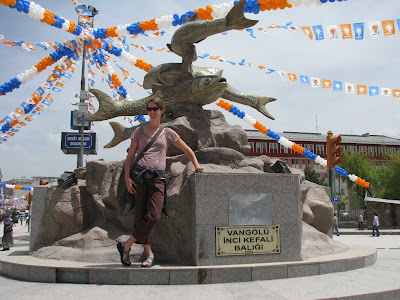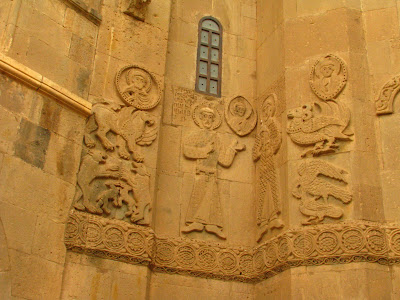
For our Youth and Sports Day Holiday (commemoration of the beginning of the national liberation movement initiated in 1919 by Atatürk's landing in Samsun & dedicated to the youth of Turkey), my friends and I flew eastward to Van, Turkey. With a population of 600,000, it is situated on a 4,000 square kilometer freshwater lake nestled against snow-covered mountains. As far east into conservative Turkey as it is, it's more "cosmopolitan" feeling that one would think. This whole combination reminded me of Missoula, Montana, as much as a town not too far from the Iranian border can remind one of Montana.




This was my first time staying in one of Turkey's oğretmen eviler, or "teacher houses." Not only is "teacher" a respected enough profession to earn you your career's name on your tombstone along with only soldiers and doctors, but being a teacher also allows you to stay in any of these teacher hotels which are situated all over the country. They're often quite basic, but safe and affordable. You live dorm style, in that you share your room with other teachers, and there are common reading areas on each hall (because us teachers ALWAYS have to read, even on vacation), as well as a garden outside for breakfast. Dale's roommate, Ozgur, ended up joining us for the weekend's adventures. He is in the middle of his compulsory teaching placement in Hakkari, a small town nestled in the mountains near the Iraq border, three hours from Van. From him, I learned that a new teacher has 3 compulsory placements at the beginning of his career, one uncomfortable, one semi-comfortable, and one very comfortable. So after living on the very comfortable Aegean Sea, they placed him in the heart of Kurdish unrest. From a hiker/skier's perspective, Hakkari is in a prime spot. Unfortunately, these mountains are totally off limits due to the dangers.




As each town in Turkey is known for some culinary treat, Van is known for its breakfast. So our first morning we took a walk down to "breakfast street" as we called it.

After breakfast, we decided to take a trip to the "Cat House" (Kedi Evi) to see the famous Van kitty. Van cats are famous for their two different colored eyes and their ability to swim. It used to be that you could see them around the city, in shop's, etc.. But now they're so well-protected, our only opportunity to see them was at a breeding house on a university campus on the outskirts of the city. The mini-bus kept going and going, and then dropped us off in the middle of nowhere it seemed, where we followed signs to the "Kedi Evi." Weird.





After our morning seeking out the kitties, we set off on a journey to Akdamar, an island just off Lake Van's southern shore. But first, lunch on the quay (my new Scrabble word).



Akdemer is an Armenian church built between 915 and 921 AD. The Armenians were the first nation to adopt Christianity as their official religion. Van used to be the capital of the Armenian Kingdom, and its churches are sprinkled throughout this region. However, Akdemer, due to its location and exterior engravings is one of the most famous.




The church is very small, only 15m by 12m. The reliefs on the outside bear Biblical stories.




Here's Jonah and the Whale:

Samson and Delilah:

Gagik the builder-king presenting a model of the church to the clergy:

The inside of the church was less impressive and told the church's age, as most of the frescoes were worn off.



Around the church were khatchkars - Celtic-looking, very ornate crosses- carved into the rocks. They looked like teetering tombstones.


After tea in the tea garden, we raced to the top of the island.





The water of Van is the same aqua blue as the Mediterranean.



Crows and seagulls playing together:
On our second day, we explored the Van Castle. This fortress has been inhabited by different people throughout time. The Urartian's from the 9th century BC, built a temple on its side, and carved cuneiform reliefs. The Armenians' presence can be seen from the top of the fortress, where you can look down on what remains of "Old Van."







Old Van was destroyed in 1915; only a few mosques and fragments of an Armenian church remain. The Armenians began arriving from the Caucasus area around 500 BC and successfully battled for independence from Parthian and Roman hands. Under the Romans and Byzantines, Armenia played a large role in the growth of Christianity. Towards the end of the 3rd century, they adopted Christianity. However, the Armenian Apostolic Church differed from the Byzantine in belief over the co-existent nature of Christ, as the Armenians believed that the human part of Christ was absorbed in the divine. This religious antipathy over time fatally weakened the Armenian Empire so that the Selçuks absorbed them, and then they found themselves in Ottoman hands. As to what happened in 1915, supposedly during the global conflict of 1912-1915, Armenia thought it a good time to try establishing an independent Armenian state centered on its traditional territories. As a result, local Turks and Kurds attacked Van's Armenian civilians, who had barricaded themselves in the old town. From above, the Armenians' walled quarter was then pulverized by heavy artillery. The fighting ceased temporarily when Russians took the town in May 1915 and when the Ottomans counterattacked, the remaining Armenians fled with the Russian army.
Here is what's left of Old Van below:



Van Lake beyond:



After venturing into town for dinner, we came back out to catch the sunset from atop of the castle:



Then, on our last night, we stopped for baklava at a place owned by people from Gazianteppe (the town famous for pistachio baklava as opposed to walnut baklava which the rest of the country serves).


Back home in Ankara the next day, I still felt the spirit of the east around me. I love visiting eastern Turkey as it is so alive with tension and change and the fervent pride of minority groups. And of course, the hospitality of this country does not stop at ethnic Turks; the Kurds and Arabs I have met in eastern Turkey have made my visits there extra special. Whenever anyone asks me where my favorite place in Turkey is (I've seen A LOT of Turkey at this point), I cannot pick ONE place, as it's the combination of all these different places that uphold and support the beauty of each other. For example, Istanbul would not be as interesting to me if I had not see the small town of Van, and the Mediterranean resort town of Fethiye would not be beautiful if I had not seen the small conservative town of Amasra on the Black Sea. I remember before arriving in Turkey reading in my guidebook that this country is a land of opposites and contradictions. And though this has been proven true by my travels, these opposites have less of a polar effect and are more of a paradox or a gestalt. Despite the tensions between political parties, ethnicities, and regions, there is a harmony to all these opposites that is really quite beautiful.

